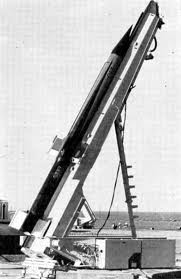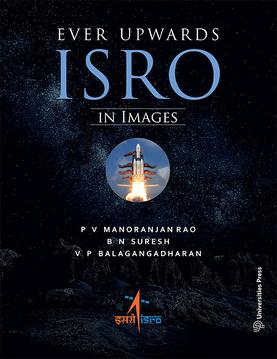
The Vikram Sarabhai Space Centre (VSSC) is a major space research centre of the Indian Space Research Organisation (ISRO), focusing on rocket and space vehicles for India's satellite programme. It is located in Trivandrum, in the Indian state of Kerala.
Thumba is a coastal area of Thiruvananthapuram city, the capital of Kerala, India.

Bélier is the designation of a French sounding rocket family. Three versions of the Bélier were launched between 1961 and 1970 at the CIEES launch facility at Hammaguir, the Salto di Quirra and Ile du Levant missile ranges, and Kourou Space Center.

The Dragon is a two-stage French solid propellant sounding rocket used for high altitude research between 1962 and 1973. It belonged thereby to a family of solid-propellant rockets derived from the Bélier, including the Centaure, the Dauphin and the Éridan.

Centaure was a two-stage French sounding rocket consisting of a Venus first stage and a Belier second stage. It belongs to a family of solid-propellant rockets consisting of the Belier, Centaure, Dragon, Dauphin, and Eridan.

The Uchinoura Space Center is a space launch facility in the Japanese town of Kimotsuki, Kagoshima Prefecture. Before the establishment of the JAXA space agency in 2003, it was simply called the Kagoshima Space Center (鹿児島宇宙空間観測所) (KSC). All of Japan's scientific satellites were launched from Uchinoura prior to the M-V launch vehicles being decommissioned in 2006. It continues to be used for suborbital launches, stratospheric balloons and has also been used for the Epsilon orbital launch vehicle. Additionally, the center has antennas for communication with interplanetary space probes.
DGA Essais de missiles is a launch site for the test of military rockets and for launching sounding rockets in France. "DGA Essais de missiles" is situated between Biscarrosse and the Atlantic Ocean. "DGA Essais de missiles" went in service in 1967 as replacement for the former launch sites at CIEES, Hammaguir.

Arcas was the designation of an American sounding rocket, developed by the Atlantic Research Corp., Alexandria, Va.

Satish Dhawan Space Centre – SDSC, is the primary spaceport of the Indian Space Research Organisation (ISRO), located in Sriharikota, Andhra Pradesh.
The Indian National Committee for Space Research (INCOSPAR) was established by India's first prime minister Pandit Jawaharlal Nehru under the Department of Atomic Energy (DAE) in 1962, on the suggestion of the scientist Dr. Vikram Sarabhai, recognising the need in space research. It committed to formulate the Indian Space Programme. At the time, the committee was part of the Tata Institute of Fundamental Research. The committee took over the responsibilities of the Department of Atomic Energy in space science and research. The then director of the DAE, Homi Bhabha, was instrumental in creation of the committee.

Launch Area 3 (LA-3) at the Wallops Flight Facility is a launch complex which was used, mostly by Scout rockets, between 1960 and 1985. Forty-one Scout launches occurred from the complex, making both orbital and suborbital. In addition, four Nike sounding rockets were launched from the complex in 1970.

Rohini is a series of sounding rockets developed by the Indian Space Research Organisation (ISRO) for meteorological and atmospheric study. These sounding rockets are capable of carrying payloads of 2 to 200 kilograms between altitudes of 100 to 500 kilometres. The ISRO currently uses RH-200, RH-300,Mk-II, RH-560 Mk-II and RH-560 Mk-III rockets, which are launched from the Thumba Equatorial Rocket Launching Station (TERLS) in Thumba and the Satish Dhawan Space Centre in Sriharikota.

Andøya Space, also named Andøya Space Center and formerly Andøya Rocket Range, is a rocket launch site, rocket range, and spaceport on Andøya island in Andøy Municipality in Nordland county, Norway. Since 1962, over 1,200 sounding and sub-orbital rockets of various configurations have been launched from the site.
KVD-1 was an upper stage LOX/LH2 cryogenic engine developed by the Isayev Design Bureau (now KB KhIMMASH) of Russia in the early 1960s. It is a modified version of the RD-56, developed for a never-completed cryogenic upper stage of the N-1 super-heavy lift rocket, with the goal of enabling crewed lunar missions by the USSR. The KVD-1 produces a thrust of 7.5 tonnes.
The Interarmy Special Vehicles Test Centre (CIEES) (French: Centre Interarmées d'Essais d'Engins Spéciaux) was France's first space launch and ballistic missile testing facility. Outside France, the facility is often referred to by the name of the nearest town, Hammaguir (also called Hammaguira). It was established on 24 April 1947, by ministerial decree as the Special Weapons Test Center (CEES, Centre d'essais d'engins spéciaux) for use by the French Army. In 1948, it was turned over to the French Air Force, who renamed it CIEES. Its remote location in the middle of the Saharan Desert and its relative closeness to the Equator (compared with Metropolitan France) made it an attractive launch site for missiles and orbital rockets.

Ever Upwards: ISRO in Images by P. V. Manoranjan Rao, B. N. Suresh and V. P. Balagangadharan — all of them former scientists of the Indian Space Research Organization — is a coffee table book on the history of the Indian Space Research Organisation.

AgniKul Cosmos Private Limited is an Indian aerospace manufacturer based in National Centre for Combustion R&D (NCCRD) of IIT Madras, Chennai. The start up aims to develop and launch its own small-lift launch vehicle such as the Agnibaan, capable of placing 100 kg (220 lb) payload into a 700 km (430 mi) orbit. The first commercial launch was expected in 2022. However, no launch happened in that year. The first suborbital mission will be conducted on 22 March 2024. This did not happen either. The company tried twice to launch its suborbital rocket in March and April but postponed due to technical issues.
Kulasekarapattinam Spaceport is the second spaceport of the Indian Space Research Organisation (ISRO), located in Kulasekarapattinam, a coastal village in Thoothukudi district of Tamil Nadu, India. The facility is being constructed over 2,350 acres. As of September 2023, more than 90% of land has been acquired and the groundbreaking was done on 28 February 2024.













